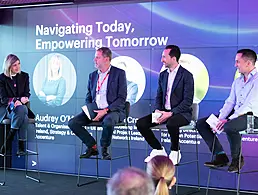BrightHR’s Alastair Brown discusses the top HR tech trends that will affect the world of work next year, such as cloud technology and generative AI.
With a new year right around the corner, now is a great time to check out the top tech trends that will shape your world of work in 2024.
With the rapid tech changes we’ve seen in the last year, it’s essential for business owners to keep updated to stay ahead!
So, what kind of things are you likely to see in the tech space next year and how will this impact your business, people and HR planning?
Recruitment will get a tech turbocharge
January is always a busy time for hiring and onboarding. That’s why in 2024, it’s predicted more employers will adopt new technologies to streamline processes, keep track of candidates and speed up the often lengthy recruitment process.
With the war for talent still raging, speeding up processes should be high on your Christmas wish list for the new year.
Out with the old and in with the cloud
Cloud-based technology will be adopted by more companies in 2024. Even the more traditional industries like healthcare and the legal sector have started to embrace the cloud and AI to speed up their processes and conduct research.
In fact, 90pc of companies surveyed by Deloitte consider the cloud essential for growth, digital transformation and maintaining a strong position in the marketplace. But how does it intertwine with your HR and people processes? Well, digital technology can help your business in many ways, such as making your daily operations easier and more cost-effective.
Cloud-based HR systems help to combine all your day-to-day people management tasks into one piece of software. They’re usually hosted on a server, meaning your team can access everything they need to whenever and wherever they’re working.
And as new and more cost-effective solutions are consistently being developed to help, the cloud is becoming increasingly accessible for business owners.
Gartner predicts that by 2027, companies will use industry cloud platforms to accelerate over half of all key business projects, making its continued rise a frontrunner in our predictions for 2024.
Remote work slows down, but it’s still here to stay!
If the tail end of 2023 has taught us anything about remote working, it’s that more employers are requesting a return to the office full-time – even those in the tech space!
Though slowing down, the shift towards remote work still exists, and according to a survey conducted by the University of Galway, 44pc of workers would change job to meet remote working needs.
Because new and changing regulations about hybrid and remote working are constantly popping up, it might be a good idea to pay attention to these key areas in 2024:
Flexible Working
Review your existing HR policies on homeworking, flexible working, hybrid and agile working.
Organisation and Management
Organise how workers will be managed and supervised and introduce HR technology where needed to support your team.
Health and Safety
Check if your insurance or liability policies need updating and pay attention to your health and safety policies too! Home working risk assessments are a great way to protect your business and keep staff safe when they’re working remotely.
Confidentiality
Make sure you have a secure system in place that allows you to keep your confidential information safe and secure.
Equipment and Tax
Stay attuned to your responsibilities for providing equipment and employee tax implications.
It’s essential you have the right technologies and HR policies to keep your hybrid and remote employees productive and happy.
Conducting a home-working assessment, having a hybrid working-from-home policy and introducing solid working-from-home guidance are all great places to start.
Generative AI is on the rise!
That means tools that generate content in a click, like ChatGPT. These are likely to expand and find multiple uses beyond the generation of words, images and chatbots. Content creation is traditionally the most common use for this tool, but it’s expected to spread its wings into other areas in 2024.
Tools like ChatGPT have many useful functions for employers and employees alike especially if the list of things it can help with is only growing. But with any new technology, it’s best to do your research and vet it properly, use it as your first draft, fact-check and use it in moderation as an assistance tool rather than an end-to-end work tool.
Employee health and wellbeing goes digital
Last year 86pc of employees said they were more likely to apply to work for organisations that were open about supporting mental health and wellbeing.
For this reason, as well as rising concern about employee mental wellbeing and increasing staff burnout, we anticipate there will be a greater need for HR solutions with digital employee wellbeing services.
Alastair Brown is the chief technical officer at BrightHR. A version of this article was previously published on the BrightHR blog.
10 things you need to know direct to your inbox every weekday. Sign up for the Daily Brief, Silicon Republic’s digest of essential sci-tech news.




